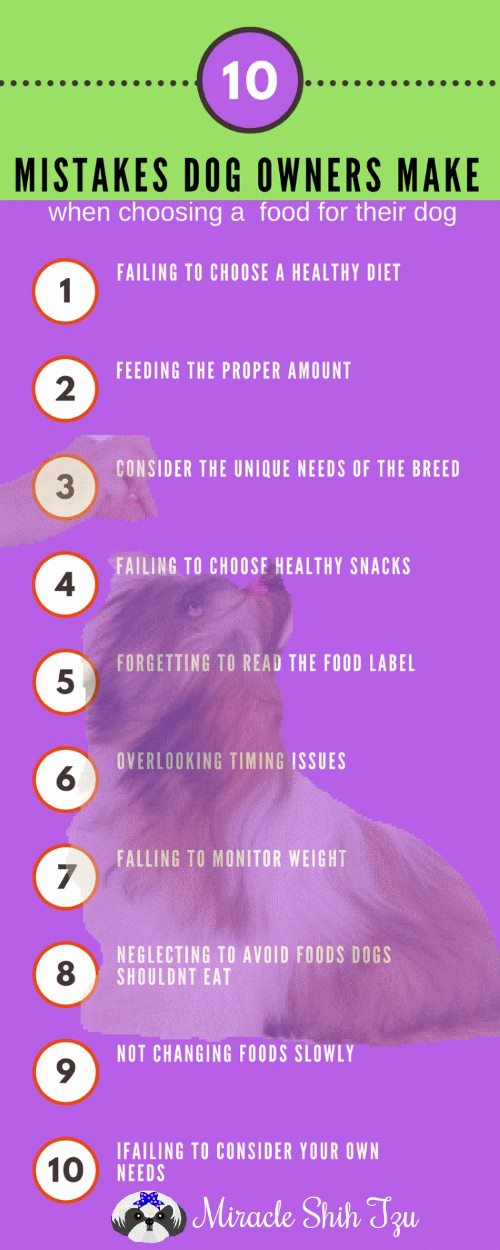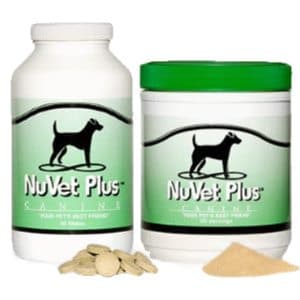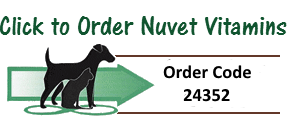Shih Tzu Food -
10 Common
Mistakes Dog Owners Make
Shih Tzu Food: 10 Common Mistakes Dog Owners Make
By Janice Jones
Shih Tzu lovers want to provide the best Shih Tzu food for their fur babies but often fall short for many reasons.
In this article, I will describe the unique needs of the breed, discuss why we may not feed the best, and then look at the most common mistakes that dog owners make. I'll also discuss any advancements in the pet food industry that might affect your dog.
Shih Tzu Food: The Unique Needs of this Breed
Each breed has its own idiosyncrasies that set it apart from others. The Shih Tzu shares many of these traits with other breeds, but none should be overlooked when it comes to picking an appropriate diet.
These are:
- Brachycephalic Status,
- Long silky coat,
- High metabolic rate,
- Food allergies, especially those that affect the skin,
- Chronically upset stomachs, and
- picky eaters.
Let's look at each one individually.
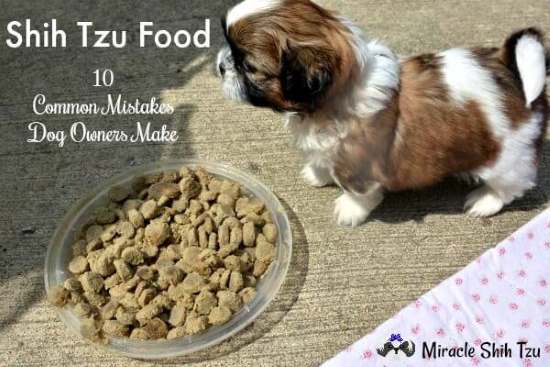 Shih Tzu Food: 10 Common Mistakes Dog Owners Make
Shih Tzu Food: 10 Common Mistakes Dog Owners MakeBrachycephalic Status and Shih Tzu Food
What, I hear you asking, has a flat face to do with Shih Tzu Food? I'm glad you asked.
As a Shih Tzu owner, you may have experienced the noisy breathing, snorting, and snoring that many Shih Tzu dogs experience, but this syndrome may also affect eating. If breathing is a problem, then eating becomes an issue because the dog is trying to do both simultaneously. When this happens, he ingests his food and extra air, causing stomach upset.
They need easy food to chew and digest. If it is a kibble, the size and shape of the kibble make a difference. Since most Shih Tzu dogs also have an under-bite, choosing a food that is easy to pick up and chew is a must.
Read more about Brachycephalic Syndrome
Feeding that Lovely Coat
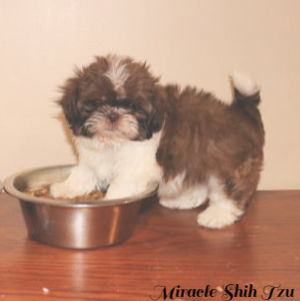
Shih Tzus has a unique coat that needs special dietary attention to keep it looking its best. As they have a long double coat, a diet high in quality proteins and fats is beneficial for maintaining their coat health.
At this point, why should I worry if I regularly keep my Shih Tzu's coat short? My answer is easy. Shih Tzu dogs kept in puppy cuts still need to look their best. Dry, brittle coats look poor and may indicate the dog is not in the best shape. No matter how many products and conditioners you put on the coat, the underlying hair is still unhealthy.
Protein is essential in a dog's diet for muscle development and tissue repair. The amino acids in proteins also feed keratin, a type of protein that makes up the hair. Healthy fats, specifically Omega-3 and Omega-6 fatty acids, help keep the skin hydrated and the coat shiny.
Protein is essential in a dog's diet for muscle development and tissue repair. The amino acids in proteins also feed keratin, a type of protein that makes up the hair. Healthy fats, specifically Omega-3 and Omega-6 fatty acids, help keep the skin hydrated and the coat shiny.
In terms of what percentage of the diet these should make, it's generally recommended that adult dogs consume at least 18% protein, while fats should comprise at least 5%. Due to their growth, Puppies require more: around 22% protein and 8% fat. However, each dog is unique and may have different dietary needs, so it's always best to consult your vet before making significant changes to their diet.
Commercial dog foods are often formulated to provide balanced nutrition, addressing these needs. Look out for dog food formulas that list a specific type of meat (like chicken, beef, or fish) as the first ingredient.
Additionally, foods or supplements that contain fish oils (such as salmon oil) or flaxseed oil can be excellent sources of necessary dietary fats. Please ensure the dog food is enriched with Omega-3 and Omega-6 fatty acids.
Skinless chicken, turkey, fish like salmon, and eggs are excellent animal protein sources for fresh foods. Sweet potatoes, peas, carrots, blueberries, and cranberries are rich in vitamins and fiber.
When feeding fresh food, the diet must be balanced, so it's best to work with a vet or a pet nutrition expert to ensure your pup gets all the nutrients it needs.
Maintaining a refreshing grooming routine with a balanced diet will ensure the health and beauty of your Shih Tzu's vibrant coat.
You can learn more about Canine Nutrition.
High Metabolic Rate and the Right Type of Shih Tzu Food
Shih Tzu dogs are classified as a toy breed. Small dogs have a faster metabolism than larger dogs, so food choices need to accommodate this fast metabolism. For example, small dogs do not eat as much as large dogs but may consume more calories per pound of body weight.
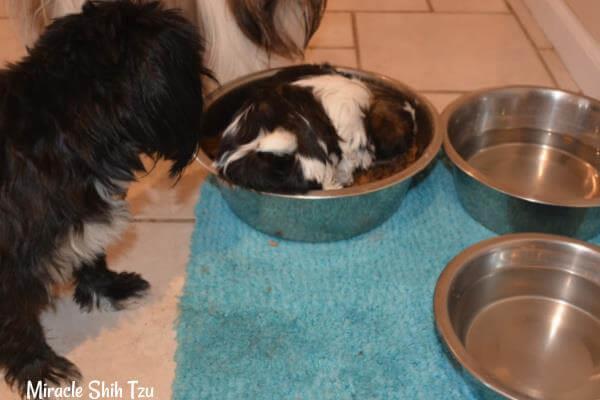
Skin Problems and Allergies
Shih Tzu dogs are often prone to skin problems such as itchy, dry skin, redness and inflammation, infections, and other conditions that cause hair loss and severe scratching. Few Shih Tzu dogs escape those allergy problems that affect so many. Red paws on white dogs, face stains, itchy ears, and constant scratching are all problematic for humans to watch, but imagine how they must feel for our fur baby.
Sometimes, food is to blame for these problems. Itching has many causes, but one cannot rule out the food one eats daily.
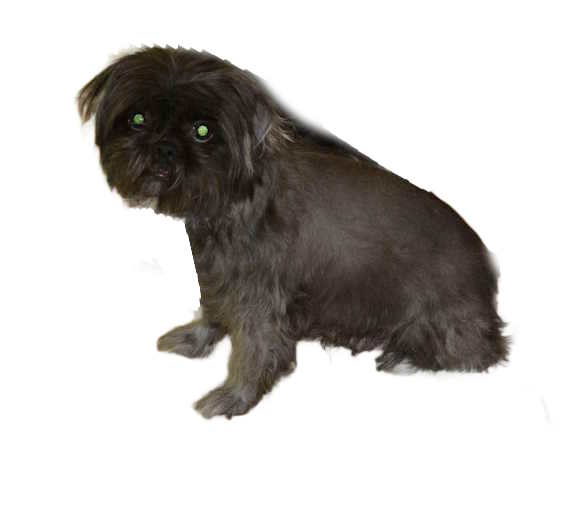 If your Shih Tzu has a dull, thin coat, it could mean allergies.
If your Shih Tzu has a dull, thin coat, it could mean allergies.Is the Shih Tzu Food You Feed Contribute to Chronic Stomach Upset
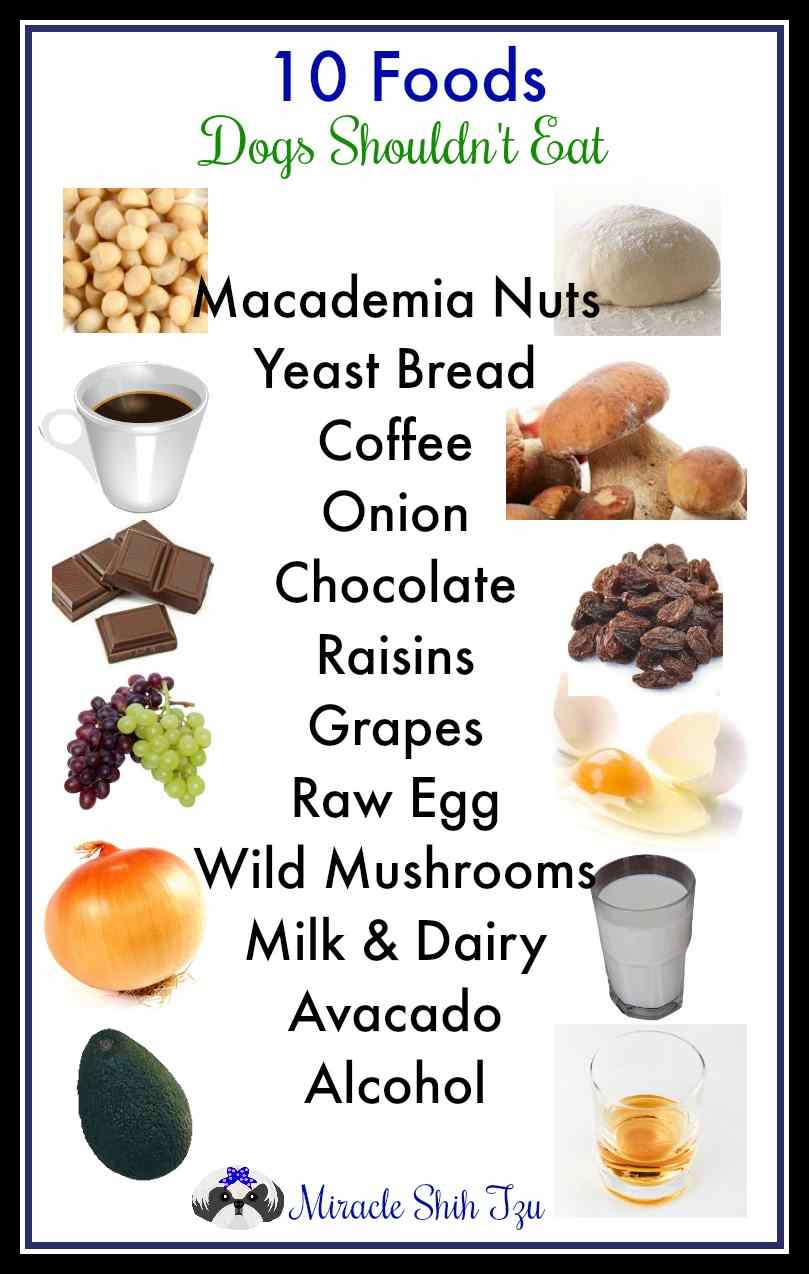
Some Shih Tzu have chronic stomach problems—loose stools, vomiting, and poor appetite. While some of these problems can be attributed to other medical problems, parasites, or food, food could be the culprit. Some of the allergies mentioned above could be associated with food, while other dogs may have food intolerance, such as to a specific protein source.
Chronic stomach upset in dogs can be a persistent issue and is often characterized by frequent vomiting, diarrhea, flatulence, loss of appetite, and overall digestive discomfort. In Shih Tzus, these issues may be triggered by certain foods or a general sensitivity to high-fat diets, fast diet changes, or, sometimes, underlying health conditions.
One potential solution to chronic stomach upset is a change in diet.
Here are a few diet changes that may help alleviate these issues:
1. Grain-Free Diets
Grain-free diets have gained popularity among dog owners in recent years. This trend was driven by concerns over potential allergic reactions to grains and an interest in providing a diet that more closely mirrors what dogs' wild ancestors would have eaten. Some dogs may be intolerant or allergic to grains, which can cause stomach upset. Switching to a grain-free diet can sometimes alleviate these symptoms.
Although grain-free diets are not for all dogs, anecdotal evidence suggests they might help improve skin and coat health, reduce allergy symptoms, and lead to smaller stools.
However, recent investigations by the FDA have linked grain-free diets to a potentially increased risk of heart disease in dogs, so it is crucial to consult with a vet before making any significant changes to your pet's diet.
However, it's essential to ensure that the diet includes other sources of carbohydrates, such as sweet potatoes or peas, that can provide the necessary nutrients and energy.
2. Single Protein Source Diet
A diet with a single type of protein can be helpful in cases where the dog has a specific protein allergy. Common proteins in dog food include chicken, beef, lamb, fish, and more. If your dog is allergic to one type of protein (for example, chicken), a diet that uses a single different protein source (say, fish) may be beneficial.
It is also a way to help determine what is causing the allergy. If you give your dog a diet consisting of only one protein source and the allergy symptoms worsen, you may have solved your mystery.
I recently switched from a salmon and turkey formula to a lamb recipe. Not all, but a couple of my dogs started itching; their ears became red and inflamed, and the white paws on my dog Dana turned red! It was clear that lamb may not be a good choice.
It's difficult to give each dog its own food formula when you have eight dogs, so I switched to a fish diet. The allergy symptoms are subsiding, and the dogs are no longer taking Benedryl.
3. Easily Digestible Diet
Easy-to-digest foods can help soothe a dog's digestive system. Ingredients like white rice, pumpkin, and certain lean meats can be more straightforward on a dog's stomach. Several commercial dog foods are marketed as easy to digest and specially formulated for dogs with sensitive stomachs.
4. Probiotic Supplementation
One significant addition to dog food recently is probiotics. These beneficial bacteria can promote a healthy gut flora, improving digestion and boosting immunity.
Some dog food manufacturers have begun including probiotics to keep dogs' digestive systems balanced and healthy, helping reduce problems like diarrhea and gas. While some dog foods include probiotics, you can also add them as a supplement to your dog's usual diet. I prefer adding them as I know exactly how much they are getting.
5. Fiber-enriched Diet
Dietary fiber can help regulate the digestive process and help with diarrhea or constipation symptoms. You should be able to see the exact percentage of fiber in a food by viewing the Guaranteed Analysis Section of the food label. If your dog might benefit from this, ask your vet. Sometimes, they can prescribe a prescription diet to meet your dog's needs.
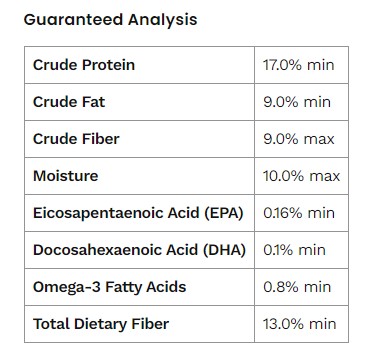 Hills Prescription Diet, Gastrointestinal Biome Chicken Flavor Dry Dog Food
Hills Prescription Diet, Gastrointestinal Biome Chicken Flavor Dry Dog Food6. Superfoods
Superfoods, such as berries, salmon, spinach, sweet potatoes, and others, have also entered the canine dietary world. Boasting high levels of antioxidants, that may help prevent cancer, healthy fats for cardiovascular health, vitamins, and minerals, these foods can provide numerous health benefits. They can help strengthen the immune system, facilitate digestion, promote joint health, and even improve mental acuity in dogs.
Some of the most common superfoods that dogs can have are:
- Blueberries
- Turmeric
- Fish Oil
- Eggs
- Kale
- Carrots
- Bone Broth
- Dark Green Leafy Vegetables
- Watermelon
- Pumpkin
You can purchase these foods as a dog food supplement, or just plan to pick some to give to your dog as a treat. My dogs love most of these foods, but the most surprising ones to me was how much they love to share my salad with me. Who Knew!
7. Organic Foods
Like humans, organic food can be an excellent option for Shih Tzus if chosen carefully. Organic pet foods are produced without artificial additives, preservatives, genetically modified ingredients, growth hormones, antibiotics, and pesticides, providing a clean source of nutrition.
They rely on natural sources of protein, carbohydrates, and fats, leading to products generally free from unwanted chemicals and toxins.
Organic diets may provide several benefits for Shih Tzu dogs.
First, an organic diet can enhance a dog's overall health and energy. The nutrient-rich food can contribute to better weight management, a shinier coat, and healthier skin. It is often highly digestible and can lead to better nutrient absorption and elimination.
Second, it might reduce the risk of foodborne illnesses and allergies, as organic food is less likely to contain allergens, artificial additives, and manufactured fillers than other commercial foods. This can be important for Shih Tzus, who are often prone to food allergies.
Lastly, organic foods can support a strong immune system, helping Shih Tzus to ward off diseases more effectively. With an emphasis on quality ingredients, organic pet food can deliver a balanced and wholesome diet.
Nevertheless, it's important to note that not all organic food is created equal, and the term "organic" doesn't guarantee nutritional adequacy or quality. Shih Tzu owners should review the product's ingredients and nutritional analysis to ensure it meets the breed's specific dietary needs. Consulting with a veterinarian or a pet nutrition expert is always a wise idea when it comes to pet diet changes, especially when considering options like organic food.
Always Consult Your Veterinarian
Before making any significant changes in your dog's diet, it's best to consult with a veterinarian. Dogs with chronic stomach upset should also be seen by a vet to rule out serious conditions like pancreatitis, gastrointestinal obstruction, or certain metabolic diseases. Testing for specific food allergies or intolerances may also be recommended.
Feeding smaller, more frequent meals, rather than one or two large meals, can also help reduce the load on the digestive system. Fresh water should always be available to help keep your dogs' system flushed and hydrated.
Remember, the most suitable diet for your Shih Tzu will depend on their specific nutritional needs, overall health, and personal food preferences, and should be discussed with a professional. No one dog has problems that can be solved with these options.
Picky Eaters
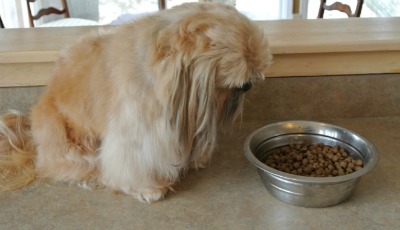
Some Shih Tzu dogs are more picky than others when it comes to the types of food they eat. Just based on casual observations of mothers and puppies, I have noticed that if moms are picky, their pups will be also.
Choosing food for picky eaters is not always easy and many people will resort to a homemade diet which may not be the healthiest choice. Cooking for your Shih Tzu may seem like a loving act, but if the meals are not complete and balanced, the lack of proper nutrients can lead to additional health issues.
Tips for Feeding Picky Eaters
If you have a picky eater, consider some of these tricks that might help:
- Using very hot water, soak the kibble until it is very soft. Allow to cool and serve the soft kibble.
- Try a different type of bowl or serve the food on a plate.
- Add a little beef, chicken, or bone broth to the kibble.
- Avoid any treats or in-between meal snacks for 24 hours; this includes things like Greenies or other edible teething chews.
- Add a different type of food. For example, if you feed kibble, consider adding a spoonful of canned food mixed with the kibble
Shih Tzu Food: 10 Common Mistakes Dog Owners Make
Here is my list of the 10 most common mistake that dog owners make when choosing a food and feeding their dog.
Failing to:
- Choose a Healthy Diet
- Feed the Proper Amount
- Consider the Unique Needs of the Breed/Life Stage/Activity Level
- Choose Healthy Snacks
- Read the Food Label
- Consider Timing Issues
- Monitor Weight Gain/Loss
- Know What Foods Dogs Shouldn’t eat
- Slowly make Changes in Diet
- Pick a Diet Right for You Too
1. Failing to Choose a Healthy Diet
There are many reasons why people do not choose a good Shih Tzu Food for their dog. Most of these reasons fall into three broad categories: Knowledge, Cost, Attitudes.
Knowledge About Shih Tzu Food
People who read widely, surf the net frequently or pose questions to their vet regularly might not understand why anyone who has a dog would make this mistake. Even though we have facts at our fingertips, the truth is that making a choice on a healthy diet is not as easy as it sounds.
This is also a modern-day problem as very few people even cared about a healthy diet for their dogs even 50 years ago. But as people search for the right foods to fill their bellies, they also want what’s right for the beloved dogs.
What exactly does it mean to provide a healthy diet to Shih Tzu does. Since dogs are likely to be eating the same food for breakfast and dinner, day after day, perhaps for their entire life, you need to be sure that they are getting all the necessary nutrients in addition to the vitamins and minerals their body needs.
Sometimes cheap dog food does not provide that type of quality. Understanding what is in the food is very important, but so are other things found on the food label that will help you decide.
Cost of Shih Tzu Food
High-quality food does not need to break the bank; you get what you pay for. Better ingredients sourced locally, processed appropriately, and distributed fresh are some things to look for when evaluating higher-quality foods.
Cheap Shih Tzu dog foods often have inferior ingredients such as artificial coloring, flavoring, and preservatives. Unnamed meat or meal sources and unnamed meat byproducts are also common in inferior foods. By unnamed meat sources, I mean ingredients such as Poultry or Poultry byproducts. Poultry can mean anything from chicken to chicken feet.
Although artificial colors are less common nowadays, cheap foods, along with artificial flavorings and preservatives, still use them.
More about health ingredients below.
If your Shih Tzu suffers stomach upsets, soy or wheat products may be the problem.
Look for:
- No artificial colors, flavors, or preservatives
- Meats and clearly labeled fish, such as Chicken, Turkey, Egg, and salmon, are produced in North America. Proteins labeled human-grade are even better. Vegetables and Fruits should also be grown and harvested in North America.
- Foods containing organ meats (liver, kidney, heart) Organ meats are the most concentrated source of vitamins (especially the fat-soluble vitamins A, D, E, and K. minerals phosphorus, iron, copper, magnesium, iodine, calcium, potassium, sodium, selenium, zinc and manganese, and essential amino acids.
- Companies that ship fresh to you from the factory
- Food that contains healthy grainsFoods that use natural preservatives such as blended tocopherols (vitamin E)
- Additives such as fish oil, omega 3 and 6, and DHA are a plus; if not, you can supplement the diet with these ingredients.
Attitude About Shih Tzu Food
Everyone has an opinion, and our attitude about food is based on our views, whether we can verbalize them aloud or they are within our unconscious minds. Some attitudes are based on facts, but many are fake news that spreads quickly around the web.
Take the notion that Shih Tzu dogs can't have corn, wheat, or soy. Many serve dogs a grain-free diet, but corn, wheat, or soy are not harmful to some dogs. They may be the source of allergies but don't rule out other ingredients that might be equally problematic.
Many people shy away from them because they believe they should do more with food manufacturers' quantities in their blends.
Corn is a good source of protein and very cheap. Some dog foods contain corn as the first ingredient, producing a protein-rich food. Corn is a plant-based protein, and dogs require meat, eggs, and fish as their main protein sources.
Conversely, the people who believe that dogs are carnivores feed only meat. A diet consisting solely of meat is just as harmful as one that relies on plants. The truth is that dogs are carnivores but also omnivores like us.
2. Failure to Feed the Proper Amount
It is often hard to tell how much food to feed a dog. Body condition may be a better gauge for food consumption than a calorie count.
EMACIATED: All bony areas of the body (ribs, vertebrae, pelvic bones) are visible from a distance; No body fat or loss of muscle mass.
UNDERWEIGHT: Feel the ribs but no fat, can see the tops of the vertebrae, pelvic bones are prominent, see waist and abdominal tuck
IDEAL: you can feel ribs without excess fat, waist tucked in, and see the waist if viewed from above belly tucked up
OVERWEIGHT: Can feel ribs with a fat covering; can see waist if viewed from above but not prominent; Can see abdominal tuck.
OBESE: Cannot feel ribs; Heavy fat deposits on vertebrae and base of the tail; cannot see or feel waist; no abdominal tuck; may see abdominal distension.
Most larger breed dogs consume about 30 calories per pound of body weight, but small breed dogs can consume much more. Shih Tzu may consume as much as 40 to 50 calories per pound of body weight daily. The average is 35 calories per pound of body weight.
These numbers mean that a ten-pound Shih Tzu should eat about 400 to 500 calories daily just to maintain weight.
Shih Tzu that are not extremely active will require fewer calories, but if your Shih Tzu is an agility star, it will likely need about 50 calories per pound per day. That doesn't sound like a lot to us, but that includes all the extras such as treats and bones you give your dog.
Every dog food label includes a feeding chart, but that should only be a starting point. As a rule, an adult Shih Tzu will probably eat about one cup of food per day.
3. Not Considering the Unique Needs of the Breed/Life Stage/Activity Level
Many dog food companies will sell a wide assortment of food from which to choose depending on the dog's life stage: Puppy, Adult, Active Adult, Senior, Pregnant, and lactating are just a few of the available formulas.
Some dog foods are meant to be used throughout the lifespan and are certified appropriate for all life stages.
This is a more traditional way of feeding a dog, as, let's face it, when our grandparents fed table scraps to their dogs long before commercial dog food became available, they did not worry about the dog's age.
The benefits of these foods are that there is no need to change foods, which means less gastrointestinal distress. The downside is that each life stage has specific needs that may or may not be addressed by a one-size-fits-all dog food.
Shih Tzu dogs benefit from a diet rich in those nutrients that nourish skin and hair. They also do best with kibble that is smaller in size.
Puppies should be fed food suitable for puppies or all life stages until they reach 10 months of age. At that point, they can eat adult food.
4. Failure to Choose Healthy Ingredients in Your Shih Tzu Food
Many different types of foods are excellent for Shih Tzu dogs. Unless your dog is ill and needs a prescription diet from your vet, you have a wide variety of foods from which to choose.
If your Shih Tzu suffers stomach upsets, soy or wheat products may be the problem.
Corn is often used as a protein source in cheaper foods because it provides a large amount of protein and is considered an energy source. Dogs are omnivores, and meat is vital for their health.
Ingredients sourced from the USA or Canada may be questionable. Some foods claim to be made in the USA, but the ingredients do not originate here. Some foods are made in other countries. Regulations in some countries are not as rigid as those in North America, so foods may be inferior.
Dry kibble has a long shelf life; however, some companies make large runs in container trucks or store shelves beyond the freshness date. Before purchasing a bag of kibble, check the freshness date. I was surprised to find out that many have already expired.
When Choosing a Shih Tzu food, Look for:
- Meats and fish are labeled Chicken, Turkey, Egg, and Salmon and produced in North America. Proteins labeled human-grade are even better. Vegetables and Fruits should also be grown and harvested in North America.
- Foods containing organ meats (liver, kidney, heart) Organ meats are the most concentrated source of vitamins (especially the fat-soluble vitamins A, D, E, and K. minerals phosphorus, iron, copper, magnesium, iodine, calcium, potassium, sodium, selenium, zinc and manganese, and essential amino acids.
- Companies that ship fresh to you from the factory.
- Dogs need carbohydrates, so pick good grains.
- Foods that use natural preservatives such as blended tocopherols (vitamin E).
- Additives such as fish oil, omega 3 and 6, and DHA are a plus
Specifically, for Shih Tzu dogs, they will need a diet with a higher content of fats. Both Omega 3 and Omega 6 fatty acids should be included. Good sources of fats include chicken fat, salmon or fish oil, sunflower oil. Coconut oil is another good source but it is not normally found in dog food.
5. Read the Shih Tzu Food Label
Before one can find the ideal Shih Tzu food, you must know what is in the food. Some ingredients are far superior to others, but unless you know what to look for, you may be misled by fancy dog food manufacturers that claim what they can’t deliver. For a basic understanding of reading food labels, start here.
Good Ingredients in Healthy Foods
- Specifically named meat or protein sources such as chicken
- Named meat or named meat meal as the first ingredient
- Meat meals are a high-quality protein source
- Vegetables and Fruits except corn
- Grains such as brown rice, oatmeal, barley, and quinoa
- Foods preserved with vitamins E and C are often called tocopherols.
- More things to look for in a healthy dog food
- Organic is even better
- Ingredients sourced in North America
- Made in North America
- Human Grade Ingredients
Ingredients in Unhealthy foods
- Corn as the first ingredient
- Unnamed protein sources such as fish, meat, poultry
- By products
- Foods that list several different forms of the exact grain (corn, corn gluten, corn meal)
- Genetic fat sources such as animal or poultry fat
- Foods that contain BHA (Butylated Hydroxyanisole), BHT (Butylated Hydroxytoluene), Ethoxyquin, PG (Propylene Glycol), Propyl Gallate, TBHQ (tertiary butylroquinone) as a preservative, may be carcinogenic.
- Artificial flavors or colors
- Avoid corn, wheat, and soy.
- Artificial sweeteners
Learn more about Reading Dog Food Labels
6. Consider Timing Issues
Dogs thrive on a predictable schedule, just like human children. They are less stressed when they know when and what will happen throughout the day.
If kibble is available all day while you are at work, they are less likely to get stressed if you get detained and cannot serve their meal at the usual time.
Shih Tzu are small dogs with small stomachs. Plan two meals daily and more for the puppy stages if feeding on a schedule. For most dogs, housetraining is easier if you can maintain this schedule.
However, Shih Tzus of smaller sizes need access to food throughout the day, as many are grazers who love to grab a small snack in between meals. If you are worried about weight gain, place the day's rations in a clean bowl so that they are available all day long.
More About Shih Tzu Food: Timing Issues
7. Monitor Weight Gain/Loss
You don't need a fancy dog scale to keep track of your Shih Tzu's weight. A simple bathroom scale will do. Weigh your Shih Tzu when you weigh yourself.
The most accurate way to do this is to weigh yourself, pick up and hold your Tzu on the scale to get a weight for both of you, and then subtract your weight.
A typical Shih Tzu reaches his adult weight between 8 and 10 months of age. By the time he is 10 months old, you will know the correct weight for his body shape.
Unless he has already gained too much weight as a puppy, this initial adult weight is a good indicator of how much he will weigh throughout his life span.
Just adding one or more pounds to a 10-pound Shih Tzu can be like an adult adding 10 or more pounds. It is noticeable, and once the weight is on, it is not so easy to remove, especially when the dog gets older and less active.
Many Shih Tzu dogs are picky and will hold out until you give them what they want. Getting a picky eater on a regular diet is as challenging as dealing with an overweight dog.
8. Know What Foods Dogs Shouldn’t eat
Most human foods are safe for dogs, but there are some exceptions, such as grapes, chocolate, and onions. There are others, too. Check out this article on foods dogs should not eat.
9. Slowly make Changes in Your Shih Tzu Food Diet
Here is one area where our dogs' eating habits differ from ours. If you want to make a diet change, do it over a week.
Slowly substituting the current food for the new food will prevent stomach upsets that can lead to diarrhea or vomiting.
When switching your Shih Tzu food, a good rule of thumb is to use this formula to change foods.
Day One: Regular Diet
Day Two: ¾ Regular diet, ¼ new food
Day Three: ½ regular diet, ½ new food
Day Four: ¼ regular diet ¾ new food
Day Five: New Food
You can adjust this if your Shih Tzu has an exceptionally sensitive stomach.
10. Pick a Shih Tzu Food that is Right for You Too
Many people stick with the food the breeder recommends, which is fine. However, your lifestyle or finances may not permit a continuation. For example, if you have fed kibble to your dogs in the past and the breeder expects you to prepare a raw diet, this may be difficult.
Some people hate the smell of canned dog food. Some people think that kibble is not healthy. Homecooked meals may be perfect for some but pose a hardship to others. As we mentioned at the beginning of this article, each person has their own bias when it comes to food.
More importantly, your lifestyle should dictate, to some degree, how you feed. Do you travel frequently? Do you have a busy lifestyle? Are there other pets in the home? Find a diet that works for you. You will be fine if it is healthy and meets the abovementioned requirements.
It might seem like rocket science, but once you know what to look for, you can pick a healthy food for your Shih Tzu.
Non-Shih Tzu Food Considerations: Sustainability and Environmentally-Friendly
Sustainable and environmentally friendly pet food options are a growing trend as more pet owners become conscious of their pets' carbon footprint. One prominent concept is "feed grade," which insists on using human-grade ingredients as opposed to traditional "feed grade" ingredients. The idea is to utilize quality byproducts of the human food industry, reducing waste and ensuring high-quality nutrition for our pets.
Brands that follow this route offer balanced diets using ethical animal sources and naturally grown vegetables, leaving a much smaller environmental footprint.
1. The Honest Kitchen—Known for being the first pet food company to have its recipes approved by the FDA as human-grade, The Honest Kitchen adheres strictly to making dehydrated pet foods sourced from human food suppliers, which means humans could technically eat the ingredients.
2. Open Farm—This company is committed to raising the bar with ethically sourced, premium ingredients and high-quality recipes, which it calls "farm-to-bowl." It uses only human-grade meat and vegetables and prepares all its food in a human-grade facility.
Have You Thought About Dog Food Packaging?
More companies are now focusing on eco-friendly packaging solutions for their products. From using recycled materials and biodegradable packaging to recyclable containers, they work to lessen the amount of waste going into landfills. To me, this is a big deal.
Shih Tzu Food: Pin for Future Reference
"Hi, I'm Janice Jones, a former veterinary technician and Shih Tzu expert with over 40 years of experience with the breed. Through Miracle Shih Tzu, I combine my medical background and extensive breed knowledge to provide reliable, practical advice for Shih Tzu owners. My mission is to help you give your Shih Tzu the happiest, healthiest life possible through evidence-based information and real-world solutions. Whether you're new to the breed or a seasoned owner, you'll find trusted guidance here for all aspects of Shih Tzu care.
I hold an undergraduate degree in Psychology with a minor in biology, Early Childhood Education, and Nursing, and a Master's in Mental Health Counseling.
